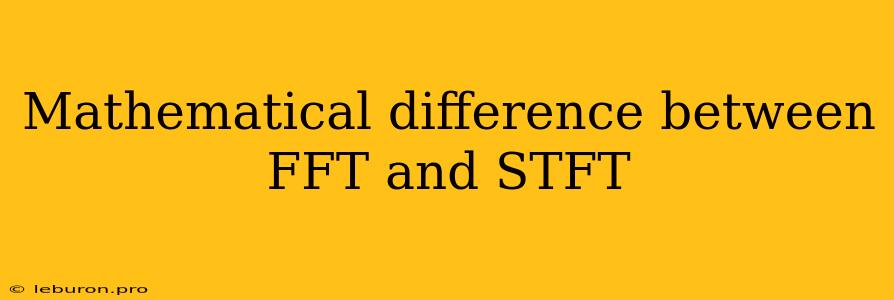The Fast Fourier Transform (FFT) and the Short-Time Fourier Transform (STFT) are powerful tools in signal processing, both used for analyzing the frequency content of a signal. While they share the core concept of transforming signals from the time domain to the frequency domain, their underlying mathematical frameworks and applications differ significantly. Understanding these differences is crucial for selecting the appropriate technique for a specific signal analysis task.
Understanding the Core Concepts
Fast Fourier Transform (FFT)
The FFT is a highly efficient algorithm for computing the Discrete Fourier Transform (DFT). The DFT decomposes a discrete-time signal into a sum of complex sinusoids at different frequencies. It essentially transforms a signal from the time domain, where it is represented as a function of time, to the frequency domain, where it is represented as a function of frequency.
Mathematically, the DFT is expressed as:
X(k) = Σ[n=0 to N-1] x(n) * exp(-j*2π*k*n/N)
where:
X(k)is the DFT coefficient at frequency kx(n)is the input signal at time nNis the length of the signaljis the imaginary unit
The FFT algorithm efficiently computes the DFT in O(N log N) time, making it significantly faster than traditional DFT algorithms which take O(N²) time.
Short-Time Fourier Transform (STFT)
The STFT addresses the limitations of the FFT in analyzing non-stationary signals, i.e., signals whose frequency content changes over time. It overcomes this limitation by dividing the signal into smaller segments, known as frames, and then applying the DFT to each frame. This process effectively provides a "windowed" view of the frequency content of the signal over time.
The STFT is defined as:
STFT(f, t, ω) = ∫[τ=-∞ to ∞] f(τ) * w(τ-t) * exp(-j*2π*ω*τ) dτ
where:
f(τ)is the signal being analyzedtis the time position of the frameωis the frequencyw(τ)is a window function that selects a segment of the signal centered at timet
The window function helps to reduce the effects of spectral leakage, a phenomenon where energy from one frequency band spills into neighboring frequency bands, by tapering the signal at the edges of the frame.
Key Differences between FFT and STFT
The primary differences between FFT and STFT lie in their application, time resolution, and frequency resolution:
1. Application
- FFT: Primarily used for analyzing stationary signals, i.e., signals with constant frequency content over time. Examples include analyzing the frequency components of a pure tone or a constant-frequency sine wave.
- STFT: Used for analyzing non-stationary signals, i.e., signals whose frequency content changes over time. Examples include analyzing speech, music, and other signals where the frequency content varies dynamically.
2. Time Resolution
- FFT: Provides a global view of the frequency content of the entire signal but lacks time resolution. It does not distinguish changes in frequency content over time.
- STFT: Offers better time resolution by analyzing the signal in short frames. The time resolution is inversely proportional to the frame length. Shorter frames provide better time resolution but poorer frequency resolution.
3. Frequency Resolution
- FFT: Provides excellent frequency resolution, especially for long signals. The frequency resolution is inversely proportional to the signal length. Longer signals provide better frequency resolution.
- STFT: Offers poorer frequency resolution compared to the FFT. The frequency resolution is inversely proportional to the frame length. Shorter frames provide poorer frequency resolution.
Choosing between FFT and STFT
The choice between FFT and STFT depends on the specific signal analysis task. Here are some key considerations:
- Stationary vs. Non-stationary signal: If the signal is stationary, the FFT is sufficient. If the signal is non-stationary, the STFT is necessary.
- Time resolution: If precise timing information is crucial, the STFT is preferred with shorter frames.
- Frequency resolution: If high frequency resolution is required, the FFT or the STFT with longer frames are suitable.
Applications of FFT and STFT
Both FFT and STFT have numerous applications in various fields:
FFT Applications
- Audio processing: Analyzing and synthesizing sounds, compressing audio files, noise reduction.
- Image processing: Image compression, edge detection, pattern recognition.
- Communications: Modulation and demodulation of signals, spectrum analysis.
- Scientific research: Analyzing data from experiments, simulations, and measurements.
STFT Applications
- Speech processing: Speech recognition, speaker identification, noise suppression.
- Music processing: Music analysis, instrument identification, audio effects.
- Medical imaging: Analyzing medical signals, detecting anomalies, diagnosing diseases.
- Geophysics: Analyzing seismic data, identifying geological formations.
Conclusion
The FFT and STFT are powerful tools for analyzing the frequency content of signals. The FFT excels at analyzing stationary signals, while the STFT is ideal for non-stationary signals. Choosing the appropriate technique depends on the specific application and the desired level of time and frequency resolution. Understanding the mathematical foundations of these techniques is crucial for effective signal analysis and interpretation.
